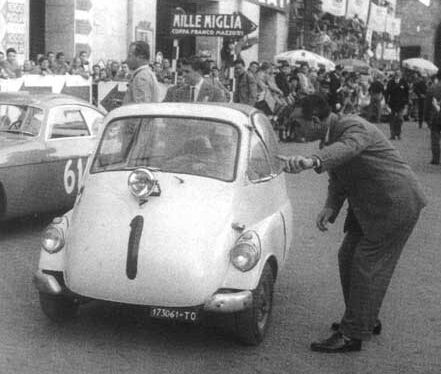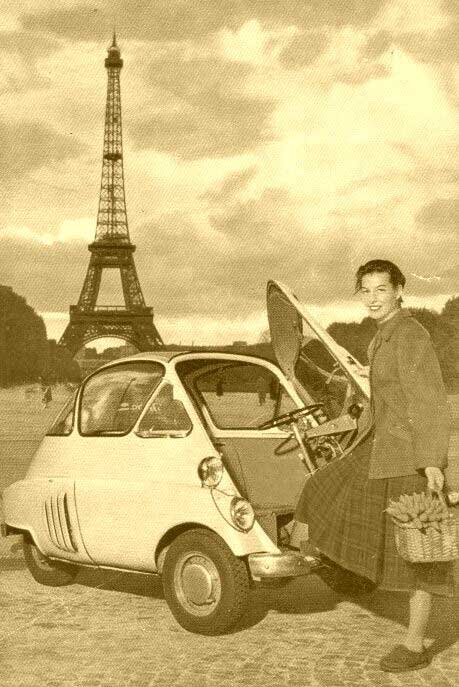1955 – The Italian creativeness and the BMW revivalby Ruggiero Capone
 Sometimes it happened that an Italian idea is exploited to revival a foreign industry. This has historical evidences, as the Japanese motorcycle production, or the Chinese and Indian electronic manufacturing. And this is the case of Renzo Rivolta too, who in 1953 presented the Isetta.
Sometimes it happened that an Italian idea is exploited to revival a foreign industry. This has historical evidences, as the Japanese motorcycle production, or the Chinese and Indian electronic manufacturing. And this is the case of Renzo Rivolta too, who in 1953 presented the Isetta.
Isetta was an innovative car: 2,25 meters long, 25 km on one liter of fuel, one front hatch that seemed especially made for easy parking. A limited length rear axle consented to get rid of the gear, allowing a perfect road holding on full-of-holes roads (a course for our cities still today).
Practically, Rivolta and his designers didn’t plan an original mini car for the post war period: they really launched the philosophy of the city car. And it was a considerable city car for that period, if you think that at 1954 Thousand Miles Isetta got excellent performances, keeping an average of 70 km per hour with a maximum speed of 85 km.
 BMW bought the project and in 1955 launched Isetta on the market, with some differences in the mechanics and other components. So BMW was able to keep alive its car sector, that at that time had on its price list only a 6 V, a pre-war mechanics, and a new, very light 8 V. So in 1959 BMW knew how to move towards the new market of BMW 700 (with a twin-cylinder air-cooled motor derived from the motorcycles). In any case, BMW acknowledged its acquaintance with Italy, cooperating with Giovanni Michelotti in the design of BMW 700.
BMW bought the project and in 1955 launched Isetta on the market, with some differences in the mechanics and other components. So BMW was able to keep alive its car sector, that at that time had on its price list only a 6 V, a pre-war mechanics, and a new, very light 8 V. So in 1959 BMW knew how to move towards the new market of BMW 700 (with a twin-cylinder air-cooled motor derived from the motorcycles). In any case, BMW acknowledged its acquaintance with Italy, cooperating with Giovanni Michelotti in the design of BMW 700.
BMW produced Isetta from 1955 to 1962, in different models. BMW 600 four-door was introduced in 1957 and sold in 160.000 specimens: a huge success, if we consider its performances and characteristics. Isetta was exported in the USA and produced under trading license in Europe and South America, where its collectors are now numerous. From Isetta to BMW 700, the German car producer inaugurated a successful strategy, changing itself in world leader. Even when financial experts, according to facts, suggested an association with other companies, BMW went on its way. What a Teutonic character, fantastic!
 In Italy, instead of remember Isetta as a fruit of our genius, we think of it as a commercial flop because of its limited success in our country. A short netsurfing is sufficient: only foreign websites recognize its success. So our mind goes to Vespa 400, that is manufactured abroad only. And it is rumoured that the new Piaggio’s misfortune was due to the fact that it had two seats only, unlike the new 500 (born in 1957) which had 4.
In Italy, instead of remember Isetta as a fruit of our genius, we think of it as a commercial flop because of its limited success in our country. A short netsurfing is sufficient: only foreign websites recognize its success. So our mind goes to Vespa 400, that is manufactured abroad only. And it is rumoured that the new Piaggio’s misfortune was due to the fact that it had two seats only, unlike the new 500 (born in 1957) which had 4.
Maybe at that time a nearly monopolist colossus like Fiat obstructed other competing firms’ success? And why did Innocenti discontinue the Mini production? Yes, these thoughts run together with the presentation of the new 500 (big).
 Maybe we should emphasize the Italian spirit of the “City Cars” project. However, it’s the same Smart’s philosophy, and the same of Isetta. How can we deny that Mercedes didn’t close its assembly line thanks to Italy, its first client? Well, we invented the city car and we saved from failure everybody manufactures them. We are really a people of generous inventors.
Maybe we should emphasize the Italian spirit of the “City Cars” project. However, it’s the same Smart’s philosophy, and the same of Isetta. How can we deny that Mercedes didn’t close its assembly line thanks to Italy, its first client? Well, we invented the city car and we saved from failure everybody manufactures them. We are really a people of generous inventors.

